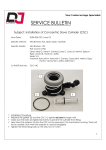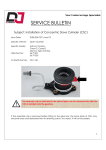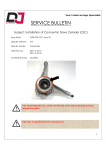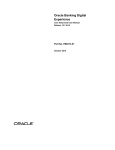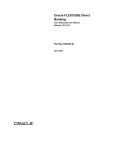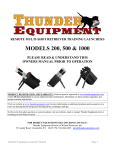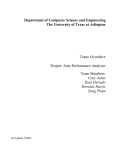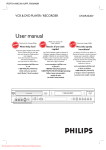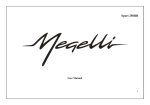Download General Fitment - Cape Parts Distributors
Transcript
SERVICE BULLETIN Subject: Installation of Concentric Slave Cylinder (CSC) Issue Date: DJSB-022-CSC-Apr/12 Specific Vehicle: General Tools / Parts Needed: DJ PARTS Brake Fluid DJ PARTS Concentric Slave Cylinder The concentric slave cylinder (CSC) is subjected to just as much natural wear as the clutch or flywheel and should be replaced every time the clutch is changed. There are a few important things to consider during installation in order to preserve the functionality and service life of the components. 1. What to do: Do not depress the pedal several times in succession when bleeding; depress just once and wait for hydraulic system to stabilize (risk of over pressure inside CSC) Do not use any lubricants or cleaning agents as they may damage the gaskets or the entire cylinder. Always maintain high level of cleanliness. Only use brake fluid approved by the car manufacturer. Clean old gaskets or remove it (if supplied with CSC) and clean dust from the connection piece/area. Clean the transmission input shaft and verify not excessive wear on shaft seal swept area. 1 SERVICE BULLETIN Make sure the slave cylinder is installed flat against the transmission-mounting surface Ensure the adaptor is engaged before finally tightening the fixing bolts on the CSC. Install the slave cylinder fixing bolts and tighten per the vehicle manufacturer requirements. Fill the reservoir with an approved DOT 3 or 4 brake fluid. NEVER bleed the CSC if the clutch and flywheel are not yet assembled (reaction load to CSC) Make sure the CSC is not inclined/tilt during installation. Failure may lead to damage at the lugs or reduced service life (Refer to angular misalignment). Do not over tighten bleed screw. Bleed screw torque for Plastic housing (3 to 5 Nm) - for Aluminium housing (15 to 20 Nm) 2. Angular misalignment 1: parallel offset; 2: Angular offset Excessive axial or angular (or both) CSC assembly error (reference to gear shaft) lead to a reduced functional and service life of CSC reducing the life of the shaft seal (gearbox input shaft seal). The root cause for excessive axial or angular (or both) CSC assembly error is to be found in alignment errors between engine and shaft. Possible cause of misalignment are: Centring between engine and gear box is not correct (deformation, heavy dirt or wear); Other parts (e.g. grounding straps) trapped between engine and gear box during installation); Flange bolts loose or not properly tightened; Close-tolerance sleeves or pins missing / damaged; Gearbox input shaft with no guidance as pilot bearing in the flywheel is absent or badly worn; Clutch bell housing warped because attaching bolts have not been evenly tightened or deformed due to the effect of force such as dropping or striking hard when fitting; 2 SERVICE BULLETIN In case of excessive axial and angular misalignment and shaft seal wear, shaft rotation can generate mineral oil mist that could go in contact with internal CSC primary seal with high volume change leading to leakage and low service life. 3. MANDATORY Bleeding Procedure A brake bleeding device should not be connected and switched on during manual bleeding. If the clutch pedal is actuated with a brake bleeding device connected, the concentric slave cylinder can be “over-pressurized”. An “over-pressurized” concentric slave cylinder is no longer able to function and must be replaced! Manual bleeding should be carried out using the following process: a) Depress clutch pedal; b) Open bleed valve; c) Keep clutch pedal depressed until fluid appears – Do not release! d) Close bleed valve; e) Release clutch pedal slowly; CAUTION!! DO NOT DEPRESS THE CLUTCH PEDAL IN SEVERAL TIMES IN quick SUCCESSIONS DURING BLEEDING; DEPRESS SLOWLY ONCE AT A TIME The clutch bleeding cycle must be repeated 20 to 25 times (recommended) to guarantee complete bleeding. Top up the level of the fluid in the reservoir between the cycles. The level of the fluid must not drop below the minimum mark on the reservoir during bleeding! Problems with bleeding mainly occur in concentric slave cylinders with bleed valves in the hydraulic line. It is recommended only bleeding these systems manually. CAUTION!! ALWAYS USE DOT3 OR DOT4 BRAKE FLUID AS RECOMMENDED BY SERVICE MANUAL. DO NOT USE MINERAL OIL PREFER MANUAL BLEEDING FOR CSC DISCARD USED OIL IN ACCORDANCE TO COUNTRY REGULATION. 3 SERVICE BULLETIN 4. Brake Fluid / Clutch System/ CSC cleanliness Contamination may cause sporadic leaks when dirt articles accumulate under the sealing lip and may also cause permanent leaks when the lip seal swells CAUTION!! Exclusively use brake fluid with at least DOT 3. When open, do not store the fluid longer than one year. Change the fluid at planned interval (Refer to car owners’ manual) Drain the used fluid and rinse the line system with sufficiently new fluid. Remove the compensating reservoir and clean it carefully. The entire CSC system must be free from oil and grease. Otherwise the lip seals swell. Avoid grease on hands and oil on cleaning rags. Make sure to remedy any leaks on engine and gearbox. Make sure that the gear bell housing is sufficiently sealed. In order to avoid contamination during repair work, always close hydraulic and pipe connectors properly, For further enquires, consults our friendly DJ PARTS service dealer in your area. Note : Whilst every precaution has been taken to ensure the accuracy of the information given on these tables, DJ AUTO ASIA PACIFIC PTE LTD disclaim all liability for the consequences for any information which may be shown incorrect. 4




